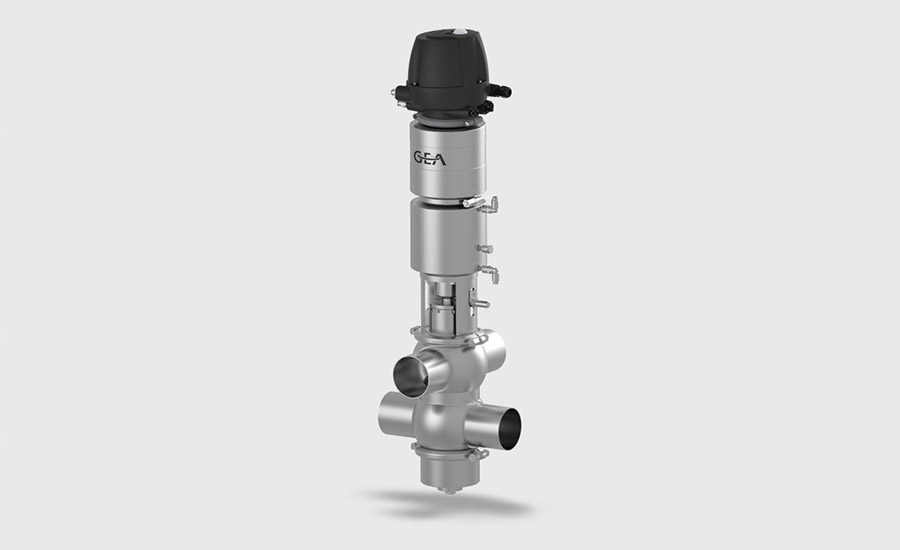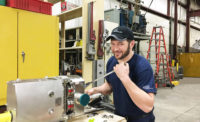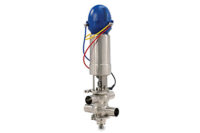Moving products effectively and safely through a dairy processing system can be tricky with seemingly minor components playing major roles.
This includes pumps and valves, which are crucial elements for maintaining and boosting performance and productivity. Yet, pinpointing the optimal components for specific circumstances can be arduous.
Operators must factor in a wide range of elements, including sanitation, functionality, durability, and energy use when considering options, along with garnering the necessary information on components and tracking newer designs.
While equipment cost is a key buying parameter, performance is perhaps most crucial, says Chris Sinutko, global director of product management and engineering — nutrition, and health, for SPX Flow Inc., a Charlotte, N.C-based pump and valve supplier. He states that optimizing the dairy processing system is about finding the right equipment for the right job.

“A superior pump or valve lasts longer, performs better, and is more versatile than others, which yields benefits beyond the upfront purchase price,” he states. “Proven benefits include improvements in lifecycle duration, performance, and versatility, which are all interconnected.”
It is essential that processors select pumps and valves in accordance with the application, fluids, piping, and connection points in use, while meeting the necessary hygienic or regulatory requirements, Sinutko says.
Next is identifying the brands or manufacturers that provide the best designs, materials with a long lifecycle, and the best value in relation to upkeep, ease of maintenance, and versatility, he notes.
“It is important to consider not only the immediate existing parameters but also future operating conditions that the equipment could face, such as greater flow rates or different viscosity fluids,” Sinutko says.
Crucial too is the availability of local technical support and service; spare parts, and worker training, he states, adding that components should support sustainability by incorporating features that optimize efficiency and waste reductions.
Examine the expense
Operators seeking the best value also should analyze initial cost versus power savings when choosing pumps that will operate at peak efficiency, says Adam Koss, mechanical engineer for Koss Industrial Inc., a Green Bay, Wis.-based pump and valve supplier.
Size is a major valve consideration as smaller valves will give higher pressure drops, resulting in greater energy use, he states. “Inversely, a large valve may have more upfront cost, but lower pressure drops and therefore the pump won’t need to generate as much pressure to push across the valve, resulting in lower energy consumption,” Koss says.
In addition to operating consistently and with minimal downtime, components must withstand strenuous process conditions, states Jacqueline Debellis, regional sales manager — Northwest, for GEA Group AG, a Düsseldorf, Germany-based pump and valve vendor.
This includes being fully cleanable and drainable while enabling quick in-house servicing and featuring an intuitive and modular design to help shorten the learning curve for new maintenance professionals, she notes.
“Choosing the right pump is crucial to ensure efficient operation and product quality,” says Robert Garner, engineering manager for Glendale, Wis.-based Ampco Pumps Co. “The key lies in matching the pump's efficiency envelope to the specific application.”
It is essential, for instance, that operators consider a product’s nature when selecting vacuum pumps for processing and packaging because of differing viscosity, temperature requirements, and sensitivity to shear forces, says Peter Mauer, business development manager — food & beverage, for Busch Vacuum Solutions, a Virgina Beach, Va.-based vacuum pump provider. “Designs should provide the necessary vacuum level and air flow rate and handle the process vapors and operating environment,” he notes.
Selecting energy-efficient vacuum pumps will also minimize operating costs, Mauer says, noting that processors will reduce disposal expenses with pumps that use little or no water. “Evaluate the initial costs along with the long-term total cost of ownership,” he states. “Investing in higher-quality equipment can lead to savings over time.”
Processors should consider pump size as well, which will vary by application, flow rates, head and inlet pressures, line sizes, temperature, and product type, says Ken Meulemans, customer service manager for Middleton, Wis.-based Fristam Pumps USA.
Additional valve considerations include material type, bulk density, convey rate, flow characteristics, product temperature, operating conditions, size, and rotor type, relays Sumeer Banger, application engineer for Schenck Process Food and Performance Materials, a Whitewater, Wis.-based valve supplier.
.jpg)
Choosing high-performance components is particularly important for supporting systems that provide greater product yields and runtimes, Sinutko says. “The versatility of pumps or valves that operators can use in multiple applications or processes, such as with different fluids or varying conditions, provides an advantage,” he states.
Top-performing pumps will withstand years of wear; can manage misaligned piping with ease; and have convenient disassembly for hassle-free maintenance, Garner says. “By meticulously considering these elements, processors can choose a pump that is not just functional, but a true workhorse for their specific needs,” he states.
Preferable designs also have higher levels of capability and controls, Debellis maintains, noting that “facilities are looking to do more with less.” The components, she states, must function 24/7 and “when there is an issue, processors need to know and trust that the resolve will come as quickly and seamlessly as possible.”
Time for a change
Signs that indicate the need to replace current components with newer and more functional selections include declines in flow and pressure rates despite servicing; greater maintenance frequency; and bacterial testing failures, Garner says.
Such factors as seal failures, worn rotors, air leakage, material build up, and performance reduction also signal the need for new valves, Banger states, adding that improper equipment maintenance will impact the life of components.
“Equipment age should be a consideration as well, as there are constant innovations in the processing equipment industry and newer designs may be a better choice for your needs,” Sinutko says.
Processing volume increases can further necessitate a switch to higher-level pumps and valves because of the need to keep pace with the heavier workloads and enable greater efficiencies, Koss states.
Assessing the cost of repairs, both currently and in the future, versus the cost of a new components will help determine the best course of action, Mauer says.
Pump replacement, for instance, may be necessary when devices require more maintenance than expected and spare parts become difficult to obtain, Meulemans states. Sinutko adds that having aftermarket replacement parts on hand or quickly available is essential for responding to leakage from worn or damaged seals and gaskets.
.jpg)
The best time to replace a pump or valve, however, is before something goes wrong, Sinutko says, which makes it imperative that processors create and follow a preventative maintenance schedule that enables operators to source replacement parts from a trusted brand.
An equipment uptick
Recent component innovations include single pumps that can manage diverse types of fluids at different speeds, flows and pressures, including low-viscosity fluid like water or milk and such high-viscosity products as yogurt or cheese, he states. Newer designs also can efficiently support high viscosity flows without damaging delicate particles in recipes, Sinutko states.
In addition, valves are featuring easy-to-connect automated control units to provide detailed data points, such as the number of cycles, air pressure, and maintenance intervals, which allow operators to make better, quicker, and easier decisions, he says.
Condition monitoring systems also are utilizing sensors to analyze such parameters as temperature, vibration, and pressure to detect potential issues before they lead to pump failure and enable proactive maintenance, Mauer says. “Production downtime is an expensive problem for factories,” he notes.
Additional pump innovations include devices with front-loading seals that streamline seal replacements and often eliminate the need to dismantle piping, which is “a significant time-saving advantage,” Garner states.
Advanced components are providing greater flexibility as well, Meulemans says, including twin screw pumps that can gently pump a viscous product and smoothly support clean-in-place (CIP) applications.
New valve seat materials for cheese and other protein processing, meanwhile, are increasing the life of components, Debellis says. Other enhancements feature seat lifts that reduce CIP water and chemical consumption by up to 90 percent, Koss states.
.jpg)
Major rotary valve improvements include close clearance designs that reduce overall valve leakage, and the use of such smart features as motion sensors and valve interference detection, Banger states.
Moreover, tighter tolerance controls are making centrifugal pumps more efficient, and twin screw pumps are better managing high viscosity products while running at both production and CIP flow rates, Koss notes.
Seek expert advice
Processors can better meet pump and valve selection challenges by having vendors recommend the components that are going to provide savings, ease of operation, maintainability, and quality control, he states.
“Bringing in a pump or valve vendor to evaluate the components can lead to energy savings from putting in a properly sized component for the task at hand,” Koss notes.
Indeed, maintaining close contact with equipment manufacturers and users will allow operators to effectively analyze components, Debellis says. “Share information, success, and failures,” she notes. “Operating in an echo chamber will not produce the best possible outcome.”
Vacuum pump manufacturers also should demonstrate the expected energy and/or utility savings from their technologies and include a return-on-investment analysis, Mauer says.
“Choose a reputable supplier with a track record of providing quality products and reliable support service,” he states.
.jpg?1710441521)


